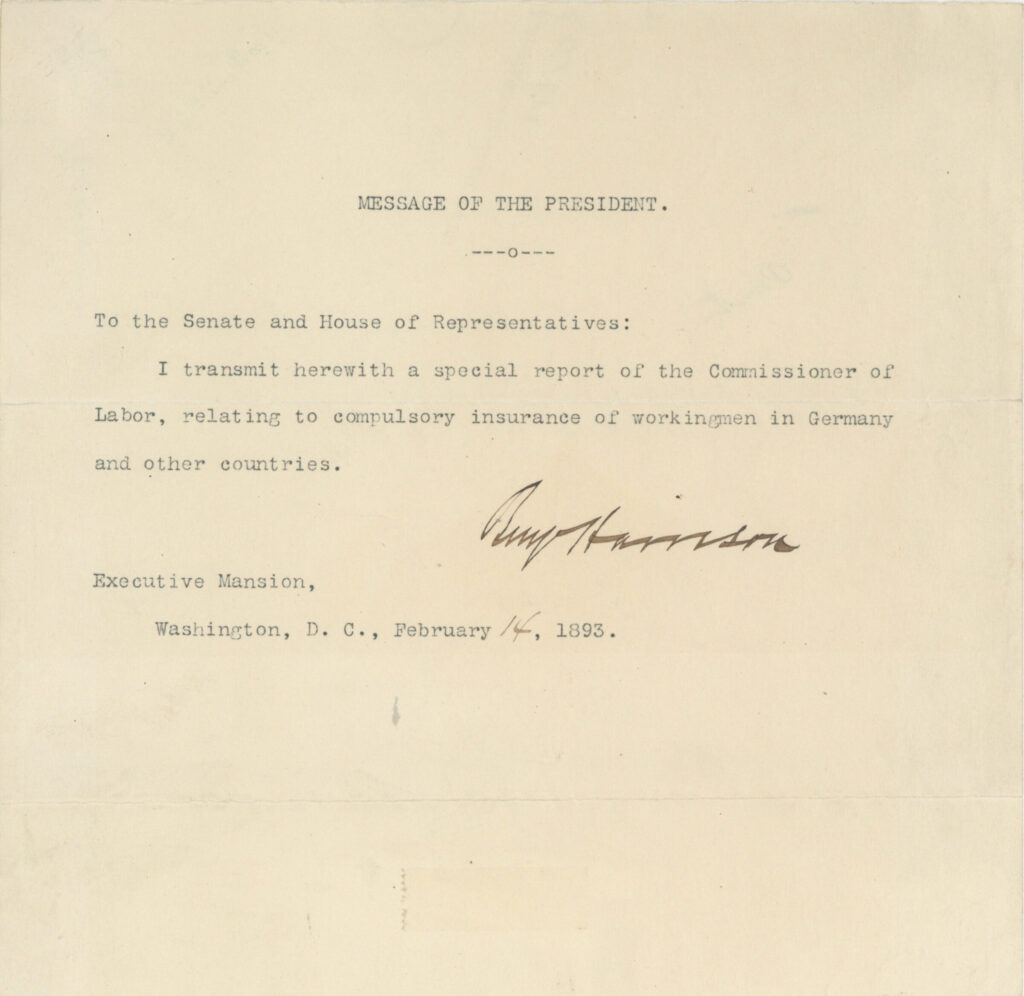The Beginning of Workers’ Compensation in the United States


President Benjamin Harrison Writes Congress, Sending a Report on the First Workers' Compensation Law - in Germany - to Serve as a Model
- Currency:
- USD
- GBP
- JPY
- EUR
- CNY
This led to the establishment of Workers’ Compensation in the United States
The watershed events in the development of modern workers’ compensation laws occurred in the improbable setting of Prussia under the leadership of its Chancellor, Otto von Bismarck. Bismarck pushed through Workers’ Accident Insurance in 1884, creating the first modern system...
This led to the establishment of Workers’ Compensation in the United States
The watershed events in the development of modern workers’ compensation laws occurred in the improbable setting of Prussia under the leadership of its Chancellor, Otto von Bismarck. Bismarck pushed through Workers’ Accident Insurance in 1884, creating the first modern system of workers’ compensation. This was followed over the next few years by Public Pension Insurance providing a stipend for workers incapacitated due to non-job related illnesses and Public Aid providing a safety net for those who were never able to work due to disability. The system as a whole valued the active worker; but the greatest benefits were granted to job-related injuries and medical care and rehabilitation were covered. The state-administered Prussian system also established an important precedent: it was regarded as an “exclusive remedy” to the problem of workers’ compensation, as employers under the system could not be sued through the civil courts by employees.
Other nations were influenced by the German model. In England, a Workers’ Compensation Act was proposed in Parliament in 1893 and was largely equivalent to the 1884 Prussian law in establishing a “no-fault” doctrine of compensation. Unlike the German model, it did not fully rely on state administration. Instead the “Friendly Societies” which had organized various forms of private disability insurance for workers for many years were relied upon to provide the insurance itself. Nevertheless, the Act encountered staunch opposition from manufacturing interests in Parliament, and the House of Lords delayed its passage for years. Finally, the Act was passed in 1897 after a four-year legislative struggles.
In the United States, a reform-minded public now came to demand changes in workers’ benefits. As early as 1893, the Department of Labor prepared a report by J. G. Brooks on the topic Compulsory Insurance in Germany, which report President Harrison sent to Congress. Congress finally passed the Employers’ Liability Acts of 1906 and 1908, softening the common-law doctrine of contributory negligence. Failed or limited efforts to pass comprehensive workers’ compensation acts were attempted in New York (1898), Maryland (1902), Massachusetts (1908), and Montana (1909). At the federal level, sentiment for modern workers’ compensation ranged a few years ahead of the state legislatures, but the matter was generally considered best left to the states. The federal government did regulate interstate commerce, however, and what is arguably the first compensation system in America was proposed by President Taft and put into law in 1908 to cover those workers involved in interstate trade. States have their own laws on the subject.
Typed letter signed as President, Executive Mansion, Washington, February 14, 1893, to the Senate and House of Representatives, sending the very report prepared by the Department of Labor assessing Workers’ Compensation and the program in Germany. “I transit herewith a special report of the Commissioner of Labor, relating to compulsory insurance of workingmen in Germany and other countries”.
Today the U.S. Department of Labor’s Office of Worker’s Compensation Programs administers four major disability compensation programs which provides to federal workers and others who are injured at work or acquire an occupational disease wage replacement benefits, medical treatment, vocational rehabilitation, among other benefits. Similar programs are at place in the states.

Frame, Display, Preserve
Each frame is custom constructed, using only proper museum archival materials. This includes:The finest frames, tailored to match the document you have chosen. These can period style, antiqued, gilded, wood, etc. Fabric mats, including silk and satin, as well as museum mat board with hand painted bevels. Attachment of the document to the matting to ensure its protection. This "hinging" is done according to archival standards. Protective "glass," or Tru Vue Optium Acrylic glazing, which is shatter resistant, 99% UV protective, and anti-reflective. You benefit from our decades of experience in designing and creating beautiful, compelling, and protective framed historical documents.
Learn more about our Framing Services









































































































